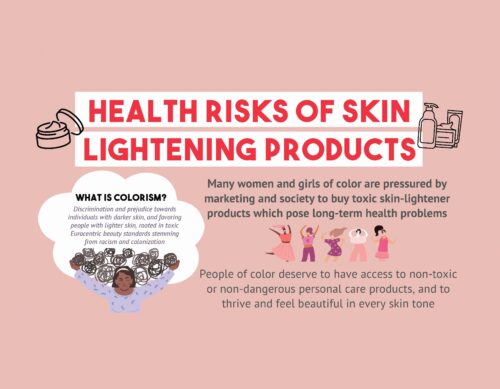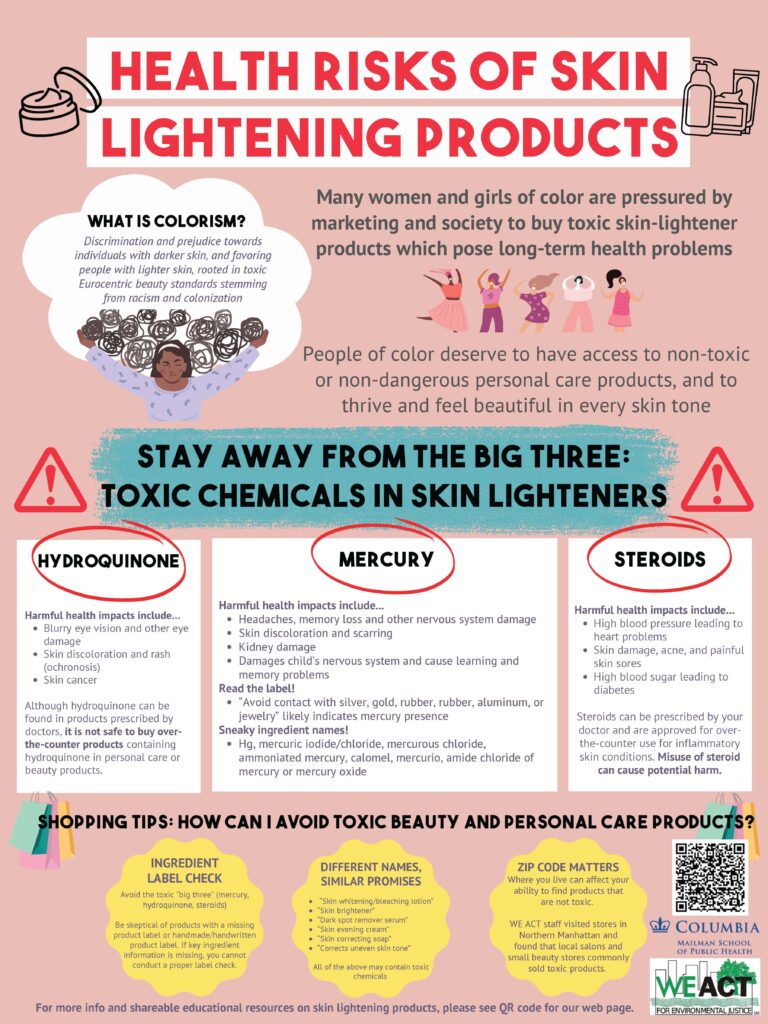Law Passed, Law Enforced: WE ACT Continues Fight Against Mercury in Skin Lighteners
In 2022, WE ACT helped pass New York State’s Mercury Out of Cosmetics law, banning the sale – both in-store and online – of cosmetics and other personal care products that contain mercury. Despite being a persistent neurotoxin that can cause kidney damage, psychosis, and peripheral neuropathy among other adverse effects, mercury is still used as a preservative in creams designed to lighten skin color. A global industry estimated to be worth $32.1 billion by 2024, skin lighteners and whiteners are marketed almost exclusively to people of color, based on the perpetuation of racist beauty standards, and because of inconsistencies in the labeling of ingredients, many users are unaware that they are applying this highly toxic substance directly to their skin.
In 2025, thanks to testing shared by WE ACT, the New York State Attorney Generals Office took action against retailers we had identified as selling skin lighteners in violation of this law.
“WE ACT for Environmental Justice is committed to seeing the proper enforcement of New York State’s Mercury Out of Cosmetics law that we helped pass in 2022, so we highly commend and sincerely thank Attorney General Letitia James and her team for conducting their own testing and taking action against the companies violating this law,” said Peggy Shepard, Co-Founder and Executive Director of WE ACT for Environmental Justice. “It is egregious to see these products being marketed to people of color, especially women and girls, taking advantage of racist, Eurocentric beauty standards that encourage them to lighten their skin. Because toxic chemicals in cosmetics and personal care products disproportionately burden women of color, WE ACT and our fellow advocates are working to ban many of these dangerous chemicals and promote the right of all New Yorkers to healthy lives.”
Explore the health risks of skin lightening products with our educational video presentation, All Shades Are Worthy: Connecting Colorism, Skin Lightening Products, & Your Health. Interested in starting conversations about beauty justice issues like colorism within your community? Scroll to the bottom of this page to access and download culturally-relevant versions of this presentation.
Health Risks of Toxic Skin Lightening Products
Skin lightening products are disproportionately marketed and used by women of color. These products can still be found in small beauty shops, salons, and 99-cent stores of predominantly Black, Indigenous, and immigrant neighborhoods of color. Unfortunately, many consumers of skin lighteners are unaware that these products are potential sources of toxic and hazardous chemicals.
Skin lightening products come in many forms such as creams, soaps, lotions, pads, and injectables. Skin lighteners may also be labeled with terms such as “bleaching”, “evening”, “correcting”, and “blemish-fading”. Once these products are applied, the toxins contained in them can be absorbed into the body. Additionally, skin lighteners used by pregnant women also expose the unborn child to potentially toxic chemicals.
To protect yourself and your community, it is crucial to learn more about what toxic chemicals exist in your beauty and personal care products, and how to avoid them. People of color deserve to have access to non-toxic or non-dangerous personal care products, and to thrive and feel beautiful in every skin tone.
Stay Away from The Big Three: Mercury, Hydroquinone, and Steroids
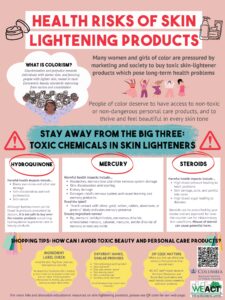 When shopping for beauty and personal care products, keep an eye out for products containing mercury, hydroquinone, steroids, and other forms of these chemicals to protect yourself from dangerous health risks.
When shopping for beauty and personal care products, keep an eye out for products containing mercury, hydroquinone, steroids, and other forms of these chemicals to protect yourself from dangerous health risks.
Mercury
While the U.S. government and state of New York have banned mercury in skin lighteners, many products are still unregulated and unaccounted for. Certain skin-lightening creams and medicated soaps purchased over the counter in New York City have been found to contain elevated levels of mercury – as high as 27,000 times the permissible limit (NYC Health Department, 2024).
Harmful health impacts include:
- Headaches, memory loss and other nervous system damage
- Skin discoloration and scarring
- Kidney damage
- Damages child’s nervous system and cause learning and memory problems
Product instructions may also be a sign of mercury. For example, if a product label says, “Avoid contact with silver, gold, rubber, rubber, aluminum, or jewelry”, it is possible that the product contains mercury likely to interact with other metals.
Keep an eye out for alternative names of chemicals containing mercury, including Hg, mercuric iodide/chloride, mercurous chloride, ammoniated mercury, calomel, mercurio, amide chloride of mercury or mercury oxide.
Hydroquinone
The U.S. Food and Drug Administration (FDA) recently warned retailers of hydroquinone-containing over-the-counter products due to potential health concerns. Although hydroquinone can be found in products prescribed by doctors, it is not safe to buy over-the-counter products containing hydroquinone in personal care or beauty products because side effects and dosage are unknown. There are no legally marketed hydroquinone-containing over-the-counter skin lightening products.
Health impacts include:
- Blurry eye vision and other eye damage
- Skin discoloration and rash (ochronosis)
- Skin cancer
Steroids
Skin lightening products specifically containing steroids may potentially cause negative health risks. Steroids can be prescribed by your doctor and are approved for over-the-counter use for inflammatory skin conditions. Misuse of steroids can cause potential harm.
Health impacts include:
- High blood pressure leading to heart problems
- Skin damage, acne, and painful skin sores
- High blood sugar leading to diabetes
Tips: How can I avoid potentially toxic beauty and personal care products?
One of our Beauty Inside Out surveys conducted in Northern Manhattan found that 25 percent of all survey respondents reported using skin lighteners in their lifetimes; among Asian respondents, use was higher at 57 percent.
Findings from a study conducted by WE ACT’s Beauty Inside Out Campaign in Northern Manhattan suggests over a third of the respondents (39 percent) of those who have used skin lightening products in the past year are not concerned about the potential negative health effects associated with usage. Similarly, 33 percent of past year users reported that they never check the ingredients of the skin lightening products.
Prepare yourself and your community with the following tips when shopping for beauty and personal care products to avoid unwanted health risks and exposure to toxic chemicals.
1) Check the label!
- Avoid the toxic big three (mercury, hydroquinone, & steroids).
- Remember that instructions (“Avoid contact with silver, gold, rubber, rubber, aluminum, or jewelry”) and alternative names for toxic chemicals such as mercury indicate potentially harmful products.
- Be skeptical of products with a missing product label, handmade product label, or label with handwriting on it. If key ingredient information is missing, you cannot conduct a proper label check.
- Tip: Use the Clearya app and browser extension to check for toxic ingredients and to help you find safe products.
2) Skin lightening products have different names, but come with similar promises. These products might also expose you to toxic chemicals.
- “Skin whitening/bleaching lotion”
- “Skin brightener”
- “Dark spot remover serum”
- “Skin evening cream”
- “Skin correcting soap”
- “Corrects uneven skin tone”
3) Your zip code matters when shopping for products.
- Where you live can affect your ability to find products that are not toxic. WE ACT staff visited stores in Northern Manhattan and found that local salons and small beauty stores commonly sold toxic products.
Colorism is Toxic, Beauty Justice for All
A survey conducted by our Beauty Inside Out Campaign found that women of color in Northern Manhattan and the South Bronx said light skin makes a woman “more beautiful” and “look younger”.
Colorism, defined as prejudice or discrimination towards individuals with darker skin, places pressure on women and girls of color around the globe to adhere to harmful Eurocentric beauty standards that promote dangerous beauty and personal care practices such as the use of skin lightening products.
Our fight against environmental racism in the beauty industry highlights that beauty is diverse and people of color deserve access to safe and healthy personal care and beauty products.
Take Action and Resources
Take action to join the fight for beauty justice and protect yourself and your community from toxic chemicals in your beauty and personal care products.
1) Engage in hard conversations with yourself and others
- Due to societal pressures favoring Eurocentric beauty standards, decide what personal care and cosmetic practices are right for you. Educate yourself and your community about the risks of skin lightening products to make informed decisions.
2) Words matter
- Choose your words carefully when talking to others – especially when you are commenting on someone’s skin.
- We often say words or phrases that perpetuate the idea that fair or light skin is favorable (“Don’t stay out in the sun too long!”).
3) Small changes can start with education and conversation
- Do you know a family or friend that may use skin lightening products? Share the tips you’ve learned to shop for personal care and cosmetic products safely!
Presentation Slides – FDA’s All Shades Are Worthy: Connecting Colorism, Skin Lightening, & Your Health
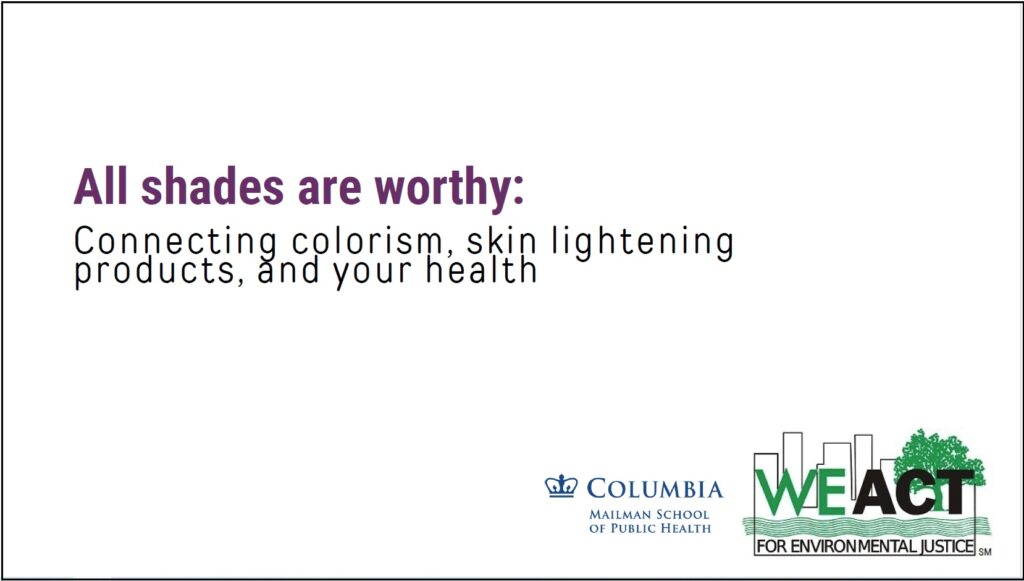
WE ACT for Environmental Justice Version (PDF)
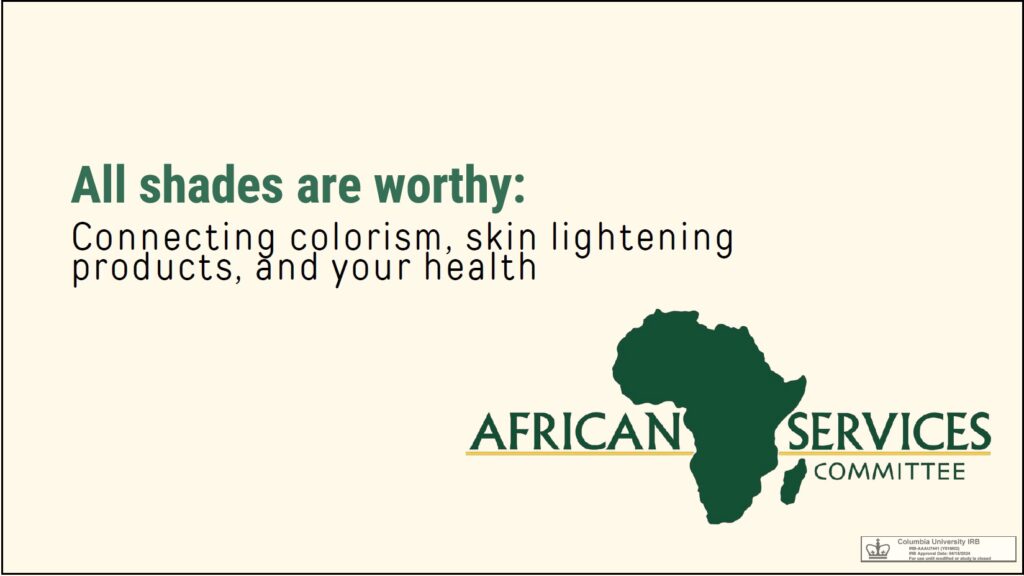
African Services Committee Version (English PDF)
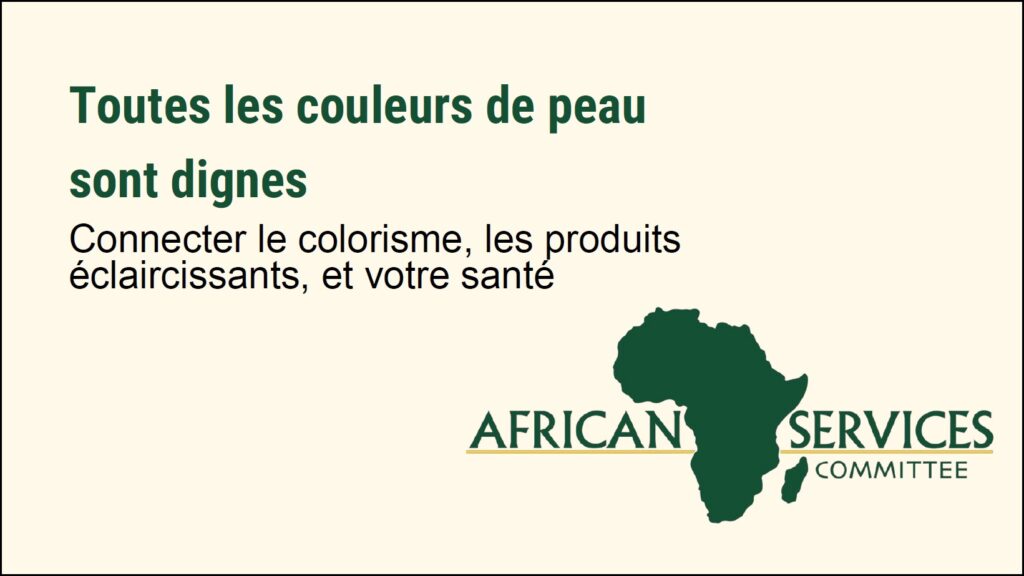
African Services Committee Version (French PDF)

Dominican Women’s Development Center Version (English PDF)
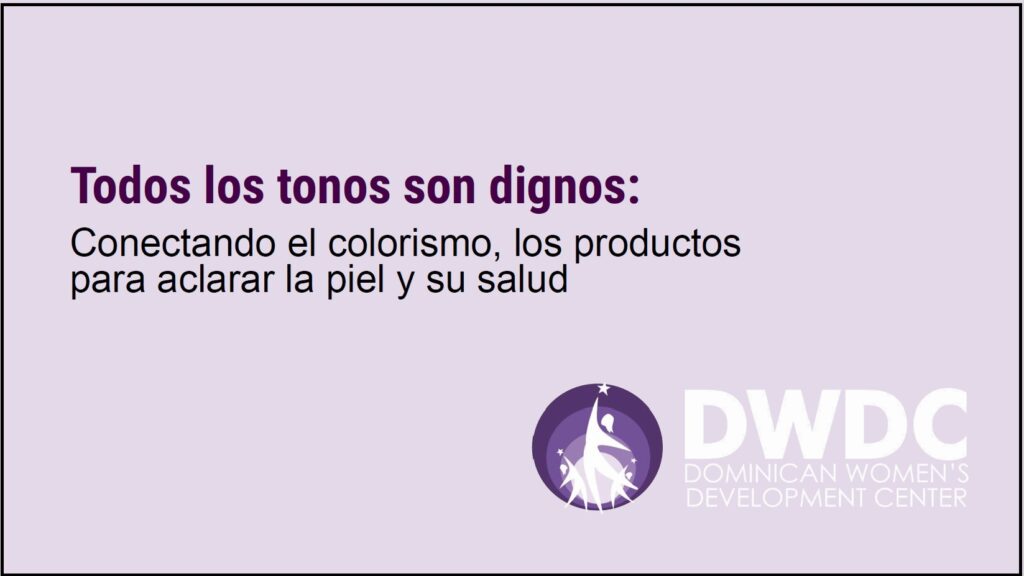
Dominican Women’s Development Center Version (Spanish PDF)
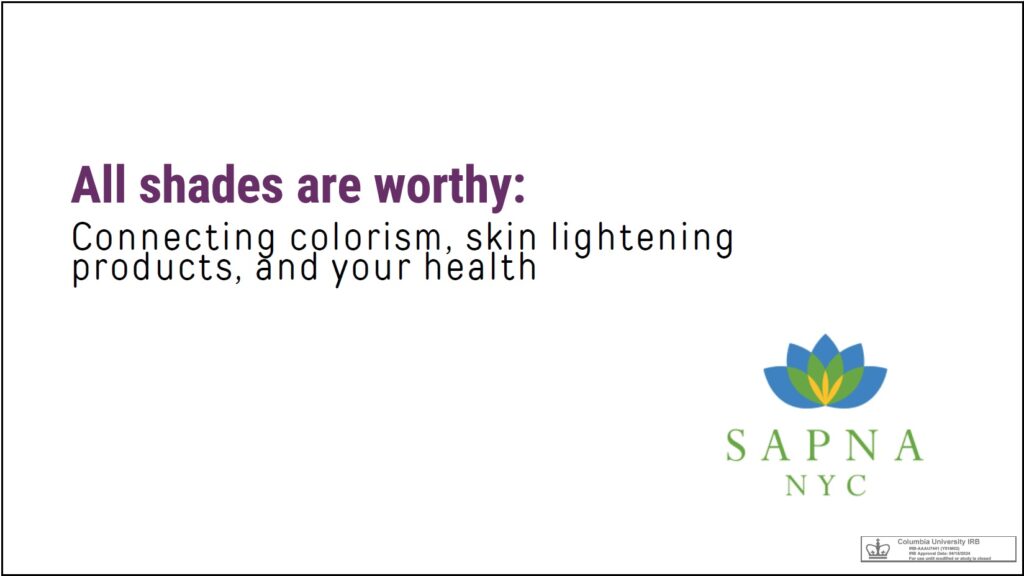
SAPNA NYC Version (PDF)
Share this webpage and our presentation slides to educate yourself and others on the dangers of skin lightening products.
